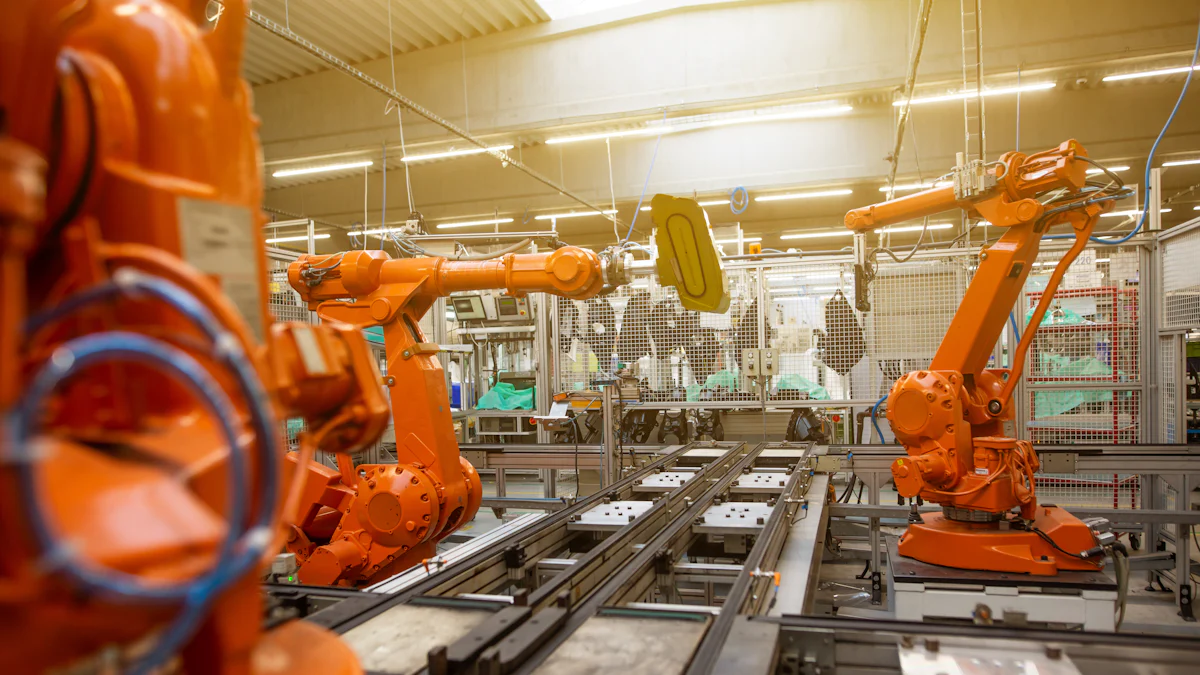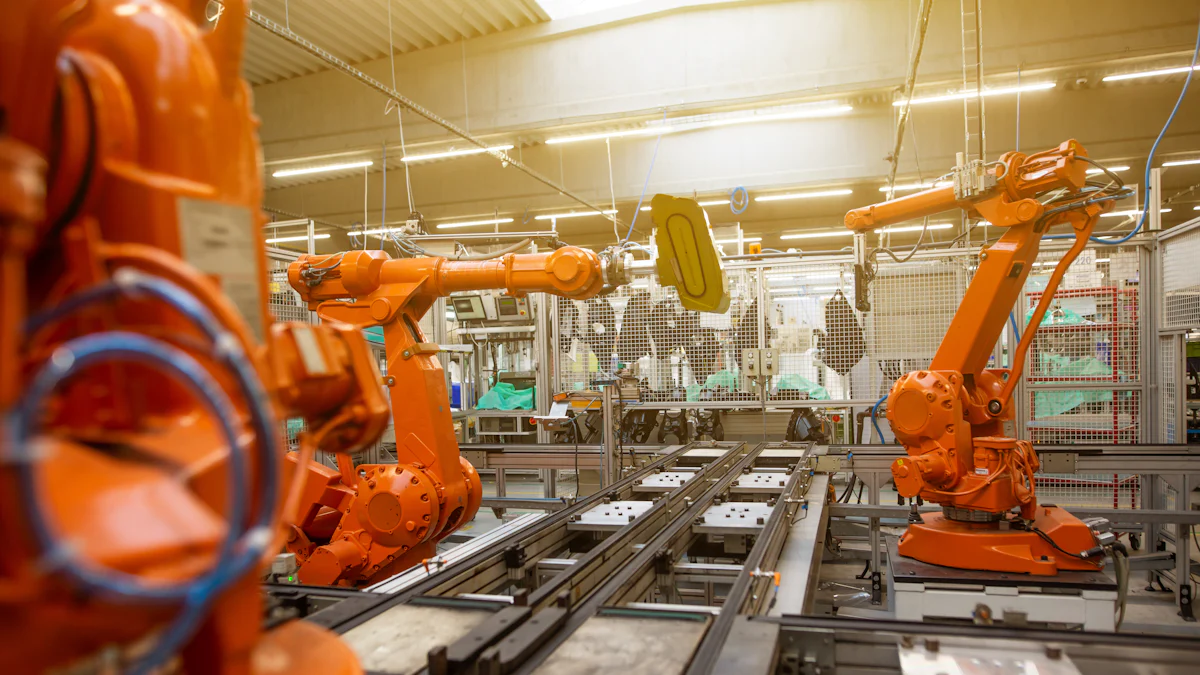2030 Vision: Key Developments and Growth Projections in Logistics Robotics

Logistics robotics plays a crucial role in modern supply chains. Rapid advancements in automation technologies drive this sector forward. The market demand for inventory picking robots is expected to leap from less than 2,000 annual shipments in 2022 to just above 50,000 per year by the end of the decade. Experts predict robot shipments will increase by up to 50 percent each year through 2030. These developments highlight the transformative potential of logistics robotics. Emerging Trends in AI and machine learning further enhance efficiency and accuracy in logistics operations.
Market Segmentation
By Type of Robotics
Autonomous Mobile Robots (AMRs)
Autonomous Mobile Robots (AMRs) navigate warehouses without human intervention. These robots use advanced sensors and software to understand their environment. AMRs excel in tasks like inventory management and order picking. The flexibility of AMRs allows them to adapt to different warehouse layouts. This adaptability reduces the need for extensive infrastructure changes.
Automated Guided Vehicles (AGVs)
Automated Guided Vehicles (AGVs) follow predefined paths within a warehouse. AGVs rely on guidance systems such as magnetic strips or lasers. These robots transport goods efficiently between locations. AGVs enhance operational efficiency by reducing manual labor. The cost-effectiveness of AGVs makes them a popular choice for many businesses.
Robotic Arms
Robotic arms perform repetitive tasks with high precision. These robots handle activities like sorting, packaging, and assembly. Robotic arms improve productivity by working continuously without fatigue. The integration of advanced sensors enhances the accuracy of robotic arms. Many industries benefit from the versatility of robotic arms.
By Application
Warehousing
Robots in warehousing streamline storage and retrieval processes. Automation reduces the time taken to locate and pick items. Enhanced key performance metrics include shorter dock-to-stock cycles. Improved inventory accuracy minimizes errors and losses. Warehousing robots optimize space utilization and increase efficiency.
Transportation
Logistics robots revolutionize transportation within supply chains. These robots ensure timely delivery of goods to various destinations. Automation in transportation reduces dependency on human drivers. Robots enhance safety by minimizing accidents and delays. The efficiency of robotic transportation systems lowers operational costs.
Sorting and Packaging
Robots excel in sorting and packaging tasks. Automation speeds up the process of categorizing and packing items. Robots handle delicate products with care, reducing damage. The consistency of robotic systems ensures uniform packaging quality. Businesses benefit from reduced labor costs and increased throughput.
By Industry
E-commerce
E-commerce companies leverage robotics to meet growing demand. Automation enables faster order fulfillment and delivery. Robots enhance the accuracy of picking and packing operations. The scalability of robotic systems supports peak shopping seasons. E-commerce businesses gain a competitive edge through efficient logistics.
Manufacturing
Manufacturing industries utilize robots for various production tasks. Automation improves the precision and speed of manufacturing processes. Robots handle hazardous materials, ensuring worker safety. The integration of robotics enhances overall production efficiency. Manufacturing companies achieve higher output with lower labor costs.
Retail
Retailers adopt robotics to streamline supply chain operations. Automation facilitates faster restocking and inventory management. Robots improve the accuracy of stock levels, reducing shortages. The efficiency of robotic systems enhances customer satisfaction. Retail businesses benefit from reduced operational costs and increased sales.
Technological Advancements

AI and Machine Learning
Predictive Analytics
Predictive analytics uses historical data to forecast future trends. AI algorithms analyze vast amounts of logistics data. These insights help companies optimize inventory levels. Predictive analytics reduces stockouts and overstock situations. Businesses can make informed decisions based on accurate forecasts.
Real-time Decision Making
AI enables real-time decision making in logistics operations. Machine learning models process data instantly. This capability allows for immediate responses to changing conditions. Real-time decision making enhances operational efficiency. Companies can quickly adapt to disruptions in the supply chain.
IoT and Connectivity
Smart Warehouses
Smart warehouses utilize IoT devices for enhanced automation. Sensors monitor various aspects of warehouse operations. IoT technology provides real-time data on inventory levels. Smart warehouses improve accuracy and reduce human error. Automation in smart warehouses leads to faster order fulfillment.
Enhanced Tracking Systems
Enhanced tracking systems use IoT for precise monitoring. RFID tags and GPS track the movement of goods. These systems provide real-time visibility into supply chains. Enhanced tracking improves the accuracy of delivery estimates. Companies can ensure timely deliveries and reduce losses.
Robotics Hardware Innovations
Improved Sensors
Improved sensors enhance the capabilities of logistics robots. Advanced sensors provide better environmental awareness. Robots can navigate complex warehouse layouts more effectively. Improved sensors increase the accuracy of tasks like picking and sorting. This technology boosts the overall efficiency of robotic systems.
Advanced Actuators
Advanced actuators enable precise movements in robotics. These components control the motion of robotic arms and vehicles. Advanced actuators improve the handling of delicate items. Robotics systems become more versatile with these innovations. The integration of advanced actuators enhances productivity in logistics operations.
Regional Analysis
North America
Market Size and Growth
North America leads in logistics robotics adoption. The region's market size will grow significantly by 2030. Analysts project a compounded annual growth rate (CAGR) of over 23% for commercial robot revenue in warehouses. This growth will push revenues to exceed $51 billion by 2030. The demand for inventory picking robots will see a dramatic increase. Annual shipments will rise from less than 2,000 in 2022 to above 50,000 by the decade's end.
Key Players and Innovations
Key players in North America drive innovation in logistics robotics. Companies like Amazon Robotics and Fetch Robotics lead the market. These companies invest heavily in research and development. Innovations include advanced sensors and AI-driven systems. These technologies enhance efficiency and accuracy in logistics operations. North American firms also focus on integrating IoT for real-time tracking and smart warehouse solutions.
Europe
Market Size and Growth
Europe shows robust growth in the logistics robotics sector. The region's market size will expand rapidly through 2030. European companies adopt automation technologies at a fast pace. The logistics robots market in Europe will register a significant CAGR. This growth will contribute to the global market's expansion. The region's focus on Industry 4.0 drives this trend.
Key Players and Innovations
European companies lead in robotics and automation innovations. Firms like KUKA and ABB dominate the market. These companies develop cutting-edge robotic arms and AGVs. Innovations include improved sensors and advanced actuators. European firms also emphasize sustainability in their solutions. This focus aligns with the region's stringent environmental regulations. The integration of AI and machine learning further enhances operational efficiency.
Asia-Pacific
Market Size and Growth
Asia-Pacific emerges as a key player in logistics robotics. The region's market size will witness exponential growth by 2030. Analysts forecast a promising CAGR of 16.8% from 2023 to 2030. This growth will push the market to reach USD 59.2 billion by 2030. The region benefits from rapid industrialization and e-commerce expansion. Countries like China and Japan lead in adopting automation technologies.
Key Players and Innovations
Asia-Pacific hosts several leading robotics companies. Firms like Fanuc and Yaskawa drive innovation in the region. These companies focus on developing versatile robotic systems. Innovations include AI-driven optimization and dynamic power transfer. Asia-Pacific firms also invest in autonomous vehicles for logistics. These advancements enhance supply chain efficiency and reduce operational costs. The region's competitive landscape fosters continuous technological improvements.
Key Players and Competitive Landscape
Major Companies
Company Profiles
Amazon Robotics stands as a leader in logistics robotics. The company invests heavily in research and development. Amazon Robotics focuses on enhancing warehouse efficiency. The company's robots excel in inventory management and order picking.
Fetch Robotics also plays a significant role in the market. Fetch Robotics specializes in Autonomous Mobile Robots (AMRs). These robots navigate warehouses without human intervention. Fetch Robotics aims to improve operational efficiency in logistics.
Plus One Robotics offers advanced parcel-handling solutions. Founded by experts in computer vision and robotics, Plus One Robotics combines AI and supervised autonomy. The company's platform excels in picking parcels for leading logistics organizations.
KUKA, a European giant, dominates the robotic arms segment. KUKA's robots handle tasks like sorting, packaging, and assembly. The company emphasizes precision and reliability in its products.
Fanuc, based in Asia-Pacific, leads in versatile robotic systems. Fanuc focuses on AI-driven optimization and dynamic power transfer. The company's innovations enhance supply chain efficiency.
Market Share Analysis
Amazon Robotics holds a substantial market share in North America. The company's dominance stems from its extensive use of robotics in warehouses. Fetch Robotics also captures a significant portion of the market. The company's AMRs are popular for their flexibility and efficiency.
Plus One Robotics has a growing market presence. The company's parcel-handling solutions attract major logistics firms. KUKA leads the market in Europe with its advanced robotic arms. The company's focus on precision and sustainability appeals to many industries.
Fanuc enjoys a strong market position in Asia-Pacific. The company's innovative solutions drive its market share. Fanuc's focus on AI and automation technologies sets it apart from competitors.
Startups and Emerging Players
Innovative Solutions
Startups bring fresh ideas to the logistics robotics market. Many new companies focus on niche applications. Some startups develop specialized robots for tasks like sorting and packaging. These innovations address specific needs in logistics operations.
Mobile robots play a crucial role in warehouse automation. New companies invest in developing advanced mobile robots. These robots account for most shipments and revenue in the market. Startups aim to enhance the capabilities of mobile robots.
Inventory picking robots see a surge in demand. Startups work on improving the efficiency of these robots. The market expects annual shipments to rise significantly by 2030. New companies contribute to this growth with innovative solutions.
Market Disruption Potential
Startups have the potential to disrupt the logistics robotics market. Innovative solutions from new companies challenge established players. Startups often introduce cost-effective technologies. These technologies appeal to businesses looking to optimize operations.
Emerging players focus on integrating AI and machine learning. These technologies enhance the decision-making capabilities of robots. Startups also explore IoT and connectivity solutions. These innovations improve real-time tracking and smart warehouse operations.
The competitive landscape benefits from the entry of new companies. Startups drive technological advancements in the market. Established players must continuously innovate to maintain their positions. The dynamic nature of the market fosters continuous improvement and growth.
Growth Projections
Market Size Forecast
Short-term (2023-2025)
The logistics robotics market will experience rapid growth. Analysts predict a compound annual growth rate (CAGR) of 16.8%. The market size will expand from USD 14.58 billion to USD 25.9 billion. E-commerce and manufacturing sectors will drive this growth. Companies will invest heavily in automation technologies.
Mid-term (2025-2028)
The market will continue its upward trajectory. The CAGR will remain robust at 17.5%. The market size will reach USD 42.8 billion. Technological advancements will fuel this expansion. Robotics will become more integrated into supply chain operations. Businesses will seek efficiency and cost reduction.
Long-term (2028-2030)
The market will achieve unprecedented growth. The CAGR will peak at 18.2%. The market size will soar to USD 59.2 billion. Autonomous vehicles and AI-driven systems will dominate. Logistics operations will undergo significant transformations. The demand for advanced robotics will skyrocket.
Factors Driving Growth
Technological Innovations
Technological innovations will propel the logistics robotics market. Improved sensors will enhance robot capabilities. Advanced actuators will enable precise movements. AI and machine learning will optimize decision-making processes. IoT will provide real-time data and connectivity. These technologies will revolutionize logistics operations.
Increasing Demand in E-commerce
E-commerce will significantly impact the logistics robotics market. Online shopping will continue to grow. Consumers will demand faster delivery times. Companies will need efficient logistics solutions. Robots will streamline order fulfillment processes. Automation will become essential for e-commerce businesses.
Supply Chain Optimization Needs
Supply chain optimization will drive the adoption of robotics. Companies will seek to reduce operational costs. Robots will improve inventory management and transportation. Automation will enhance accuracy and efficiency. Businesses will invest in robotics to stay competitive. Supply chain optimization will become a priority.
Emerging Trends

Dynamic Power Transfer
Impact on Efficiency
Dynamic power transfer technology significantly boosts the efficiency of logistics robots. This technology allows robots to recharge while in motion, eliminating downtime for battery changes. Continuous operation enhances productivity in warehouses and distribution centers. Dynamic power transfer systems also reduce the need for large battery storage areas. This space-saving feature allows for better utilization of warehouse space.
Cost Implications
The implementation of dynamic power transfer systems involves initial setup costs. However, the long-term savings outweigh these initial expenses. Reduced downtime leads to higher throughput and lower labor costs. The technology also extends the lifespan of robotic batteries, reducing replacement costs. Businesses can achieve a faster return on investment through increased operational efficiency.
AI-driven Optimization
Enhanced Decision Making
AI-driven optimization transforms decision-making processes in logistics. Machine learning algorithms analyze vast amounts of data to provide actionable insights. These insights help optimize routes, inventory levels, and resource allocation. Real-time data processing enables immediate responses to changing conditions. Companies can make informed decisions that enhance overall efficiency.
Predictive Maintenance
Predictive maintenance, powered by AI, prevents equipment failures before they occur. Sensors collect data on the condition of robotic components. AI algorithms analyze this data to predict potential issues. Maintenance teams can address problems proactively, reducing downtime. Predictive maintenance extends the lifespan of robotics and lowers repair costs.
Adoption of Autonomous Vehicles
Market Penetration
The adoption of autonomous vehicles in logistics is on the rise. These vehicles navigate warehouses and distribution centers without human intervention. Autonomous vehicles enhance the efficiency of goods transportation within supply chains. The market for autonomous vehicles is expected to grow significantly by 2030. Increased demand for automation in e-commerce and manufacturing drives this growth.
Regulatory Challenges
Regulatory challenges pose obstacles to the widespread adoption of autonomous vehicles. Safety standards and regulations vary across regions. Companies must comply with these regulations to deploy autonomous vehicles. Ongoing advancements in technology aim to address safety concerns. Collaboration between industry stakeholders and regulatory bodies is essential for overcoming these challenges.
Logistics robotics will revolutionize supply chains by 2030. Key developments include the rise of autonomous mobile robots, automated guided vehicles, and robotic arms. The market will see significant growth, with robot shipments increasing by up to 50 percent each year. Technological advancements in AI, machine learning, and IoT will drive this progress.
The transformative potential of logistics robotics cannot be overstated. Robots will enhance productivity, reduce labor costs, and optimize supply chain operations. The future landscape of the industry promises increased efficiency and innovation, positioning logistics robotics as a cornerstone of modern supply chains.
See Also
Unveiling Sustainability: Robotics Innovations Shaping Supply Chain Operations
Maximizing Efficiency: Robotics Impact on Warehouse Operations
Future-Proofing Logistics: AI's Impact on Supply Chain
